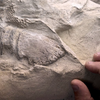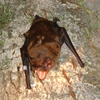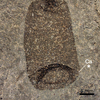Scientists Film a Colossal Squid in its Natural Habitat!

This juvenile colossal squid is the first ever captured on video
Post Author - Ellis Nolan
One hundred years after its discovery, scientists have captured the elusive colossal squid on film in its natural habitat. The juvenile squid was found around 2,000 feet below the surface of the Atlantic Ocean near the South Sandwich Islands. Measuring about one foot long, it drifts through the sea with translucent skin, pearly eyes, and colorful tentacles.
The colossal squid is the heaviest invertebrate known, with the largest complete specimen found weighing more than one thousand pounds. They have been known to grow up to 23 feet in length, however, scientists have discovered incomplete remains, such as beaks and tentacles, indicating individuals that grew even larger. They inhabit the deep seas of the southern hemisphere surrounding Antarctica, with adults usually found in what are known as the mesopelagic and bathypelagic zones, about 650-13,000 feet below the surface of the ocean. They are part of a family known as “glass squids” since, as juveniles, their skin is see-through. However, as the squid matures and its muscles develop, its skin becomes more opaque.
The massive colossal squid found in 2007
This discovery is particularly significant since colossal squid sightings are quite rare, and little is known about them. The species have very sensitive eyes and thus tend to avoid deep sea film equipment since it can be very bright. What scientists do know about the species is mostly from their remains, found in the stomachs of sperm whales and seabirds, and thus, not much is known about their diets or other everyday habits. One particular colossal squid, recovered in 2007, is the largest cephalopod specimen ever found.
The “SuBastion” submersible vehicle
The film was captured using a remotely operated research vessel called “SuBastion,” created for the Schmidt Ocean Institute. “SuBastion” is equipped with multiple scientific tools, including a 4k video camera, and all of its dives are live-streamed on the Schmidt Ocean Institute’s YouTube channel.
Interested in the creatures of the deep? Check out our sea and sand collection here!
Featured Product
Joe Frazier Boxing Glove
Cool Things!

Is “Paul is Dead” Dead?: Unpacking One Of Pop Culture’s Most Enduring Conspiracy Theories

Scientists Discover Hooves and Skin in Preserved Dinosaur "Mummies!"
A dinosaur discovery just in time for Halloween! In a new analysis of a group of fossils from Wyoming, Scientists have determined this group of fossils are dinosaur “mummies,” with preserved skin and even hooves.

Scientists Record a Bat Catching Birds Mid-Flight!
Bats, birds, screeches, oh my! In a reverse-Hitchcock twist, a new study reveals that a species of European bat catches and eats birds mid-flight.
Specimen Deep Dives

The House that Ruth Built: The Story of the Old Yankee Stadium

The Queen of the Skies: the Story of the Boeing 747

Old Ironsides: The USS Constitution and the Start of the U.S. Navy
Long Form Articles

The Artist Behind the Macintosh: Susan Kare and Apple Computers
While the two Steves, Jobs and Wozniak, are the most well known faces behind Apple computers, equally important to the products and culture of the company were those who crafted the experience of using their computers through design. The most notable of these visual architects was Susan Kare, a designer responsible for “humanizing” Macintosh computers.

Can I Lick It? Yes You Can!
Have you ever been unable to tell if a fossil was really a fossil, but you were too embarrassed to admit it? Have you ever wanted to lick a fossil just because, but you didn’t want to risk judgment from your peers? Well, good news! You can kill two birds with one stone! Licking a fossil can actually help you determine if it’s the real deal or just another rock.

Is It Legal To Own a Meteorite: How to Start Your Outer Space Collection!
Meteorites are some of the rarest geological specimens to be found on Earth. Of course, since these stones are not of our world, purchasing them can sometimes be a confusing process. Is it legal to own a meteorite? In short, yes! Read on for help starting your cosmic collection!


















